人教版新目标初中英语九年级下册You’re supposed to shake hands教案
-
- 页数:9页
- 字数:约 9987 字
- 大小:59.50KB
- 格式:.doc
- 版本:Office2016及以上版本
- 作者:二十四设计
You’re supposed to shake hands教案
语言目标:
了解一些国家的饮食起居、生活习惯和文化异同,并用学习的知识表达自己对生活习惯的看法。
认知目标:
掌握关键词汇和目标语言。

情感目标:
本单元以谈论“习俗”为话题,了解各地不同的文化知识,从而让学生知道哪些是应该做的,哪些是不应该做的,要学会尊重不同的文化,养成良好的行为习惯,培养学生的学习兴趣。
第一课时
Section A
教学目标:
1. 学习一些见面礼仪,生活习俗和对时间的看法。
2. 通过听力训练和口语练习加深学生对目标语言的认识。
3. 掌握be supposed to的句型结构
Step 1 Warm up
Ask the studentsto say out some school rules.
T: Please tell mesome school rules. Which are not allowed to do?
When the studentssay them out, write them on the blackboard. They may be “We can’t be late. We can’teat and play in class. We can play games after class.” And so on.. Then,
T: We can’t belate. That is to say, we aren’t supposed to be late. We must get to class ontime. That is to say, we are supposed to be on time.
Ask the studentsto guess the meaning of “be supposed to”. Then tell them: be supposed to =should.
Step 2 Lead in
Show a map of theworld.
T: Do you knowwhere Brazil is?
S: It is in SouthAmerica.
T: Do you knowwhere Japan is?
S: It is in EastAsia.
…….
Come up with othercountries like “ the United States, Mexico, Korea”, and ask the students totell their sites in the world. Then,
T: Do you knowwhat people do when they meet for the first time?
Raise the words“bow, kiss, shake hands, greet ”. Help students to understand every word. Thenstudents do 1a according to the instruction.
Step 3 Listening and Practising
Listen to 1b,check answers in 1a.
Then read theconversation in the picture. Ask two students to translate it into Chinese.Practise it in pairs. The students can change country names and customs whilepracticing.Then ask several pairs to act their conversations out in the front.
Step 4 Listening
2a. Listen andcheck the mistakes Maria made. Then check the answers.
2b. Listen again.Fill in the blanks. Check the answers then.
Then repeat withthe tape without looking at books. And look at the listening texts, comprehendthe conversation.
Step 5 Grammar Focus
Tell the studentsto point out the main grammar point in this lesson: be supposed to Then getsome students to read sentences in Grammar Focus and put them into Chinese.
All the studentsread them again.
Step 6 Homework
Master all thesentences in Grammar Focus.
第二课时
教学目标:
通过“应该”和“不应该”进一步了解一些国家的礼仪和对时间的看法。
Step 1 Revision
Recall themistakes Maria made in the conversation in the last lesson:
1. She arrived atPaul’s party late.
2. She kissedPaul’s mom.
3. She wore afancy dress.
Ask the studentsto say “ What was Maria supposed to do?”
1. She wassupposed to come earlier.
2. She wassupposed to shake hands with Paul’s mom.
3. She wassupposed to wear jeans and a T-shirt (casual clothes).
Step 2 Presentation
Look at the flagsigns in 3a. Ask students if they know what the two countries are. Get them tosay any information they know about the two countries.
Step 3 Reading
First raise newwords and phrases in the passages to help the students understand, like “opinion, pretty, relaxed, Columbia, drop by, Switzerland, after all”. Studentslook through the two passages and try to finish the table below the passages.Check the answers in the table.
Comprehend thepassages carefully.
Key points:
1. be relaxedabout sth “对某事随意、宽松、不严格”
例:His parents isrelaxed about his study.
2. drop by “顺便访问、拜访、看望”,也可以说:drop around, dropin, drop on sb
例:My sister droppedby last night.
= My sisterdropped around / in last night.
也可以说:My sister droppedon us last night.
3. plan to do / planon doing 表示“计划做….”
例:Where do you planto spend your vacation?
Where do you planon spending your vacation?
make a plan /plans 意思是“制订计划做….”
例:We usually makeplans to see friends.
Then read thepassages with the tape.
Step 4 Groupwork
According to thecontents in the passage in 3a, get the students to talk about the etiquette thepeople in Columbia and Switzerland should pay attention to in groups. Then askthe representatives of some groups to give their talk.
Step 5 Exercises
完成句子:
1. __________ (人们理应鞠躬) in Japan.
2. Maria___________ (穿错了衣服) at Paul’s party.
3. What ________people in Korea _________ (理应做) when they meet __________ (第一次).
4. _____________ (与佳人和朋友一起共度时光) is veryimportant to us.
5. Could you writethe words in Unit12 ___________ (不看你们的书)?
第三课时
Section B
教学目标:
1. 通过对一些国家的风俗习惯和饮食文化、餐桌礼仪的了解,进一步提高对文明生活的认识。
2. 能听懂听力课文的相关内容并完成相应任务。
Step 1 Free talk
T: What are wesupposed to say when we meet others for the first time?
S: We are supposedto say “How do you do.” or “Nice to meet you.”
T: What are wesupposed to do when we have an appointment to friends?
S: We are supposedto be on time.
T: Do you knowwhat we are supposed to pay attention to at the table?
S: We can’t makenoise while eating.
Step 2 Presentation
Look at thepicture in activity 1a.
T: What are thepeople doing in the picture?
S: They areeating.
T: How much do youknow about table manners around the world?
Allow the studentsto have different answers.
Then look at thesentences in Part 1. Comprehend every sentence. Circle “T” or “F” after eachone.
Whilecomprehending, raising two points in them.
1. pick up
a. 捡起,拾起,拿起
例:He saw a walletlying on the ground and picked it up.
b. 接人,取物
例:I’m going to pickup my uncle at the airport.
2. wipe 擦,擦去 wipe away / off 把…..擦去
例:Wipe your tearsaway.
Step 3 Listening
2a. Help thestudents to understand the instructions. Then listen to the tape and number thepictures in order.
2b. Listen again.Match sentence parts. Get the students to understand the meaning of everysentence, especially the meanings of phrases “make noise (制造噪音),stick… into….(把…..插入…..), point at (指着),walk down (沿着….走)”.
Step 4 Practising
Ask students tomake up the whole sentences according to the ones in 2b. Then some say outtheir sentences before the class.
Step 5 Exercise
Make up sentencesby using “be (not) supposed to…, be polite to…, be rude to…., shouldn’t…..”.(The sentences they make must be different from the ones in the book.)
第四课时
教学目标:
学会表达各国饮食起居、生活习俗的看法。
Step 1 Homework checking
Ask some studentsto say out their own sentences that are make up using “be supposed to…., bepolite to….” And so on.
Step 2 Reading
First, askstudents to point out the format of the passage in 3a. The conclusion is thatthe passage is an e-mail.
Students readafter the tape. Ask “Where is Wang Kun now?” What etiquette did he mention inthe passage?
After the studentsfind out the etiquette mentioned in the passage, learn it carefully.
Key points:
1. go out of theirway (to do sth) 以他们自己的方式(做某事)
例:He always goes outof his way to study.
2. feel / be athome 随便、无拘束、自由自在
例:We began to feelat home with each other. 我们之间开始无拘束了。
3. France 法国 French 法语,法国的 the French 法国人(整体) Frenchman Frenchwoman法国人(个体)
例:I met a Frenchmanduring my vacation and he taught me a little French.
4. be / get usedto 表示“习惯于….”后接n. 或v.ing。
例:I do the dishesevery day, so I’m used to it.
We are not used to getting up early.
be used to do sth 表示“被用来做某事”= be used fordoing sth.
例:This kind ofslippers is used to see in the dark.
= This kind of slippers is used for seeing inthe dark.
used to “过去常常”,后接v.原形。
例:I used to beafraid of the dark. (Unit 2)
Then studentsfinish the problems below the passage.
Check the answersby asking individual students.
您可能喜欢的文档
查看更多
人教版新目标初中英语九年级下册You’re supposed to shake hands说课稿7篇
- 页数:20页
- |大小:107.00KB
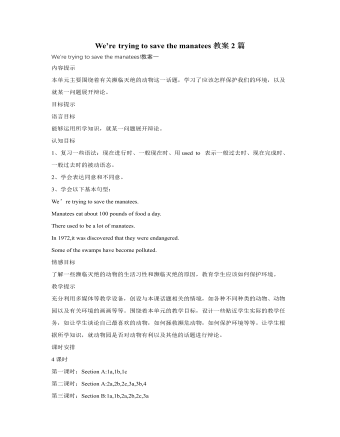
人教版新目标初中英语九年级下册We’re trying to save the manatees教案2篇
- 页数:16页
- |大小:146.50KB
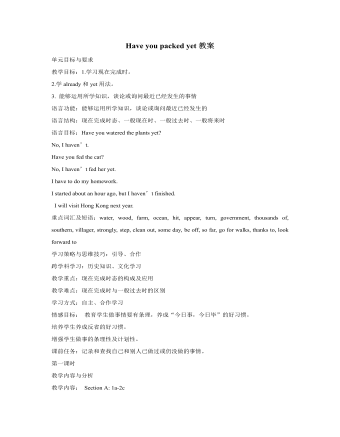
人教版新目标初中英语九年级下册Have you packed yet教案
- 页数:24页
- |大小:103.00KB
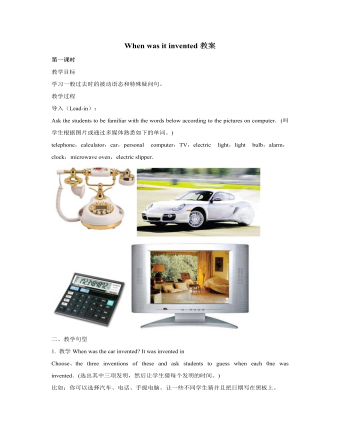
人教版新目标初中英语九年级下册When was it invented教案
- 页数:12页
- |大小:586.50KB

人教版新目标初中英语九年级下册We’re trying to save the manatees说课稿5篇
- 页数:29页
- |大小:154.50KB

人教版新目标初中英语九年级下册Could you please tell me where the restrooms are教案
- 页数:14页
- |大小:99.00KB

人教版新目标初中英语九年级上册What would you do教案
- 页数:20页
- |大小:593.50KB
热门课件教案
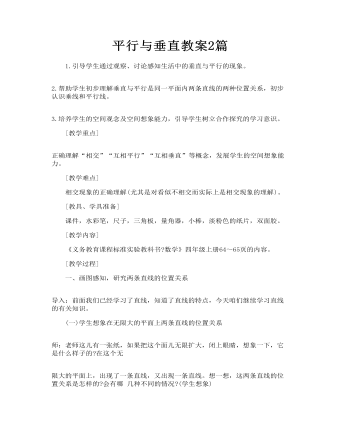
平行与垂直教案2篇
- 页数:9页
- |大小:101.04KB
- 课件教案
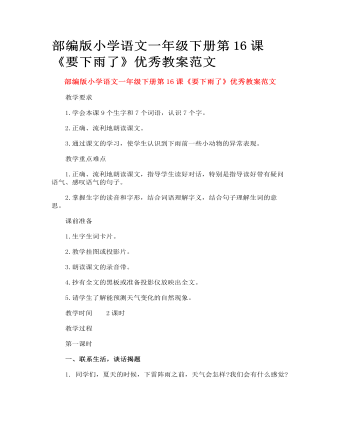
部编版小学语文一年级下册第16课《要下雨了》优秀教案范文
- 页数:4页
- |大小:19.94KB
- 课件教案

部编版语文八年级下册《马说》教案
- 页数:8页
- |大小:367.50KB
- 课件教案

部编版语文八年级下册《社戏》教案
- 页数:8页
- |大小:340.00KB
- 课件教案

精选高中生期末评语
- 页数:42页
- |大小:7M
- 课件教案

人教版高中语文《小狗包弟》教案
- 页数:8页
- |大小:29.21KB
- 课件教案
今日更新

精选高中生期末评语
- 页数:42页
- |大小:7M

××县招商局2024年上半年工作总结
- 页数:12页
- |大小:142.54KB

“四零”承诺服务创建工作总结
- 页数:5页
- |大小:39.83KB

“改作风、提效能”专项行动工作总结
- 页数:6页
- |大小:139.05KB

“大学习、大讨论、大调研”活动情况总结报告
- 页数:7页
- |大小:26.12KB

2024年度工作计划汇编(18篇)
- 页数:72页
- |大小:196.93KB





